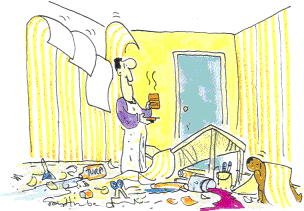Two Great British Obsessions – Tea and DIY
Moving In
Whatever the motives for DIY, and irrespective of the particular group of DIYers to which our informants belonged, they had lost their DIY virginity the day they moved into their new home, just like, we suppose, their parents and generations before. While some people in our sample had assisted friends with DIY jobs, or helped to paint their bedrooms when teenagers, it was the business of creating a home that was real DIY, not just sawing up a few bits of wood or putting up a shelf for someone else.
In this sense the DIYer is quite different from the professional craftsman. While the joiner or plumber works in other people's houses, the DIYer works only in his or her home. Every element of DIY, therefore, has special significance.
We came across people, for example, who were not content with their new home until every surface within it had been transformed by painting, stripping or cleaning. The idea that you could live in a house where your own hands had not achieved this transformation was seen as very odd by many of our informants.
For others the moving-in process had been marked more by taking things out than putting things in: "You've always got to rip something out when you move in – it's all part of the move isn't it?" This process, however, sometimes led to unfortunate results: "When we first moved in, we ripped out the kitchen sink because it was horrible. Then we realised we hadn't got one to put in its place." "When we first moved in my girlfriend took offence at the tiles on the bathroom ceiling, so she started to take them down. Then she called me up to look and there was no ceiling under the tiles at all."


